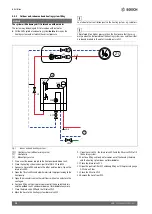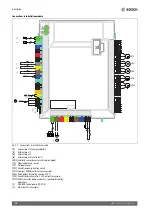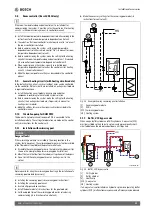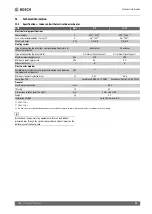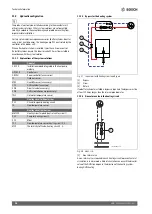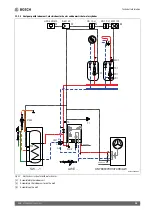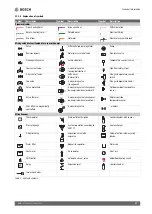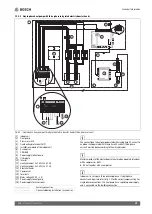
Commissioning
17
AWE – 6721835317 (2021/09)
6.2
Adjusting the operating pressure of the heating
system
Table 8 Operating pressure
▶ Top up to 1.5–2.0 bar unless otherwise specified.
▶ If the pressure does not remain constant, check whether the heating
system has any leaks and if the capacity of the expansion vessel for
the heating system is sufficient.
6.3
Operation without heat pump (individual operation)
The indoor unit can be put into operation without a connected heat
pump, for example, if the heat pump is installed at a later date. This is
termed individual operation or stand-alone operation.
In individual operation, the indoor unit only uses the auxiliary heater for
heating and DHW heating.
If the indoor unit and the heating system are to be filled before the heat
pump is connected, connect the inlet and outlet of the heat transfer
medium to/from the heat pump to ensure circulation.
▶ Open any shut-off valves that are installed in the heat transfer
medium circuit.
Commissioning in individual operation:
▶ In the
Heat pump
service menu, select the option
Operation
without heat pump
(
control unit manual).
6.4
Function test
The compressor is preheated before starting. This can take up to
2 hours, depending on the outdoor temperature. The prerequisite for
starting is that the value recorded by the temperature sensor of the
compressor (TR1) is 10 K higher than the temperature sensor at the
supply air terminal device (TL2). The temperatures are displayed in the
diagnosis menu of the control unit.
▶ Test active components of the system.
▶ Check whether the start condition for the heat pump has been
satisfied.
▶ Check if there is a heating or hot water demand.
-or-
▶ Draw off DHW or increase the heating curve to generate demand (
instructions for control unit).
▶ Check whether the heat pump starts.
▶ Make sure that no alarms are currently active.
-or-
▶ Troubleshooting.
▶ Check the operating temperatures (
instructions for the control
unit).
6.4.1
Pressure switch and overheating protection
The pressure switch and overheating protection are connected in series.
Alarms or information triggered at the control unit indicate either that
the operating pressure is too low, or that the temperature of the electric
booster heater is too high.
NOTICE
Material damage from running dry!
When the heating pump PC0 is operated for a long time when the
operating pressure is too low, it can be damaged.
▶ Eliminate any leaks in the system that are indicated when the
pressure switch is triggered.
The triggering of the pressure switch only blocks the electric booster
heater. The heating pump PC0 and the heat pump can continue to run if
there is a risk of frost.
Pressure switch
The indoor unit has a pressure switch which triggers once the pressure in
the heating system falls below 0.5 bar. Once the pressure exceeds
0.5 bar, the pressure switch is automatically reset.
▶ Make sure that the expansion vessel and pressure relief valve are
configured for the indicated operating pressure.
▶ Check for any leaks.
▶ Slowly increase the pressure in the heating system by adding water
through the fill valve.
Overheating protection (OHP)
The overheating protection triggers when the temperature of the electric
booster heater rises above 95 °C.
▶ Make sure that the particle filter is not blocked and that the flow
through the heat pump and heating system is unimpeded.
▶ Check the operating pressure.
▶ Check the heating and DHW settings.
▶ Reset the overheating protection. To do this, press the button on the
bottom of the terminal box.
6.4.2
Operating temperatures
The operating temperature check must be performed in heating mode
(not in DHW or cooling mode).
For optimum system operation, the flow rate in the heat pump and
heating system must be monitored. This check should be performed
after 10 minutes heat pump operating time and during high compressor
heating output.
The temperature differential for the heat pump must be set for the
different heating systems.
▶ With underfloor heating system: set a temperature difference of 5 K.
▶ With radiators: set a temperature difference of 8 K.
These settings are optimal for the heat pump.
Check the temperature differential at high compressor heating output:
▶ Open the diagnosis menu.
▶ Select Monitored values.
▶ Select Heat pump.
▶ Select Temperatures.
▶ Read the primary flow temperature (heat transfer medium off, sensor
TC3) and return temperature (heat transfer medium on, sensor TC0)
in heating mode. The flow temperature must be higher than the
return temperature.
Display on the pressure gauge
1 bar
Minimum charge pressure. When the system is cold, the
operating pressure must be kept at roughly 0.2–0.5 bar
above the pre-charge pressure of the nitrogen cushion in
the expansion vessel. The pre-charge pressure is 0.7–
1.0 bar as a rule.
3 bar
Maximum charging pressure at maximum heating water
temperature: must not be exceeded (the pressure relief
valve will open).








